It is very important to determine in time that a wheel puncture has occurred. While driving, pay attention to the behavior of the car: if it began to accelerate poorly, the effort on the steering wheel increased when maneuvering, or the directional stability worsened, be sure to check the pressure in the wheels.
The easiest way to repair a wheel is to go to your nearest tire shop, where the repair will be done quickly, professionally, and usually at a very affordable price. Do not try to get to the tire shop with a completely flat tire: it is enough to drive a few tens of meters in this way, and the tire will have to be thrown away.
It is necessary to replace the damaged wheel with a spare one. This rather simple operation nevertheless requires some skills.
In case of a tire puncture, turn on the alarm, brake the car smoothly to a speed of 2-3 km / h, try to carefully move to the edge of the carriageway in first gear and stop as far to the right as possible at the side of the road, and if possible, outside the carriageway. If road conditions allow and this does not contradict the requirements of the Rules of the Road, in case of a puncture of any wheel on the right side of the car, pull over to the right side of the road, in case of a puncture on the left - to the left. Try not to stop the car in places where the road is poorly visible: in sharp turns, on descents and ascents, bridges, in tunnels. If the car is left on the roadway, first of all, ensure your own safety and the safety of other road users! Turn on the hazard warning lights and set the warning triangle.
Warning: Be aware that changing a wheel in the middle of a multi-lane highway puts your life and the lives of other road users at risk. Therefore, in some cases, it is more reasonable to move the car to the curb or parking lot to change the wheel, even if this completely deteriorates the damaged tire. Life and health are more expensive than the material costs of buying a new tire.
Wheel replacement
Warning: Be careful when replacing a punctured wheel. Perhaps it was pierced by intruders to steal valuables from the car's interior at a time when you are busy changing a wheel and focusing your attention on work.
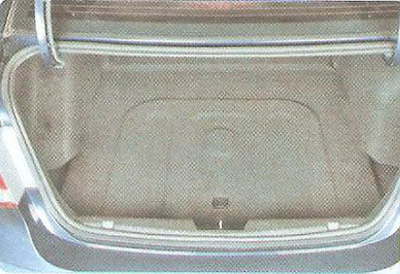
1. Open the trunk.
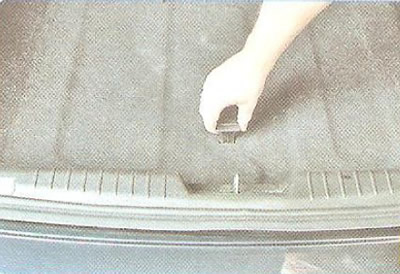
2. Grasp the handle of the hatch cover of the spare wheel well...
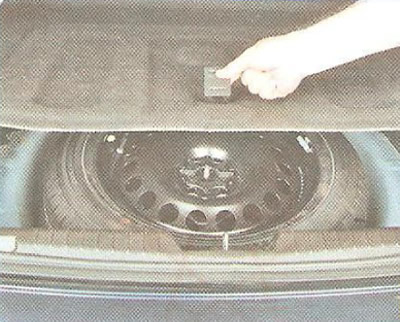
3....and lift the lid.

4. Turn away and remove a clamp.
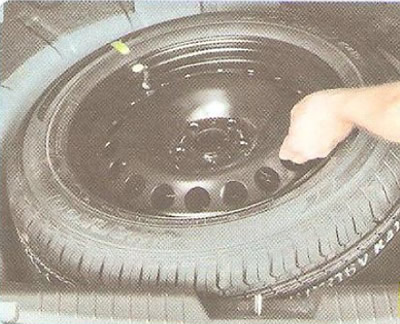
5. Remove the spare wheel from the trunk and place it under the sill next to the wheel to be replaced.
6. Engage first gear and parking brake.

7. Loosen wheel nuts.
Helpful hints: In order to make it easier to unscrew the wheel nuts, you can use your foot instead of your hands, stepping on the handle of the wheel wrench from above.
To make it easier to loosen the nuts, we recommend purchasing a special wheel wrench with a telescopic handle. It is convenient to work with a cross-shaped balloon wrench.
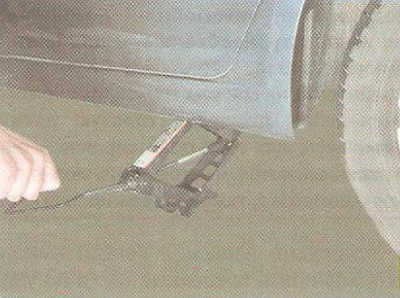
8. Place a jack under the car next to the wheel to be replaced (see «Jacking»)
Helpful Hint: In order not to get dirty when changing a wheel, put on gloves and overalls, if your car has them.
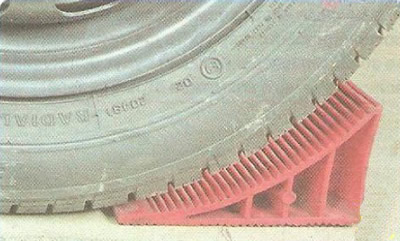
9. On the opposite side, the car must be fixed by placing wheel chocks under the front and rear wheels so that the raised car cannot move forward or backward.
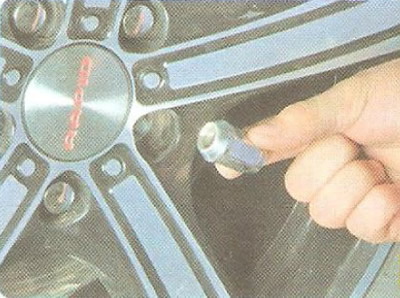
10. Raise the car with a jack so that the wheel is off the road, then completely unscrew the nuts.
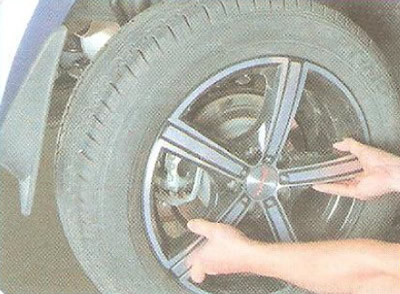
11. Remove the wheel.
Warnings: Try to keep the car as little time as possible in a suspended state with the wheel removed.
Raise the vehicle with a jack only to the height necessary to remove and install the wheel.
If working on soft ground, place a thick board under the base of the jack. Do not use bricks for this purpose - they break easily, and the car can fall off the jack, seriously injuring you.
12. Install the spare wheel instead of the removed one, screw the fixing nuts up to the stop, but do not tighten them.
Warnings: Before installing the spare wheel, thoroughly clean the mating surfaces of the wheel rim and hub to remove dirt with a wiping cloth or brush. Be careful: these parts may reach high temperatures while driving. When screwing on the nuts, make sure that their conical parts are aligned with the conical surfaces of the holes in the wheel disk, otherwise the nuts will be loosened during movement, as a result of which the wheel may come off.
13. Lower the vehicle and finally tighten the wheel nuts.

Note: Tighten the wheel nuts crosswise. To avoid damage to the wheel rim, do not attempt to «hold out» wheel nuts by pressing the wrench handle with your foot.
Helpful Hints: In order to feel the required tightening torque of the wheel nuts, first use a torque wrench (tightening torque 90-120 Nm).
Do not lubricate the fastening nuts - this can lead to self-loosening of the nuts while the vehicle is moving.
14. Before you continue driving, be sure to check the air pressure in the tire of the installed wheel.
Helpful Hints: The car is equipped with tubeless tires. If you do not have enough tire mounting skills, we advise you not to try to do this work yourself. One damage to the sidewall - and you have to buy a new tire or insert a tube.
In a hopeless situation, you can use a special first aid kit for repairing tubeless tires without stripping or a tire sealant. They must be used in accordance with the attached instructions. Why is a tubeless tire better than a tubed one? Tubeless when punctured «descends» very slowly: you can, pumping up, drive for weeks with a nail in the wheel, until it becomes possible to repair it.
